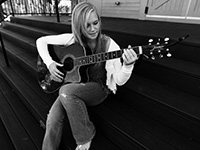Exhibit Celebrates Life and Work of the late Bill Whiting
By Jennifer Lee
Clarke County’s native son left a legacy of artwork and many friends and collectors
Anyone who knew Bill Whiting remembers his mischievous grin, twinkling eyes, and the colorful, light-filled landscapes he painted of the surrounding countryside … and the cows. “Bill was famous for his cows because he could make sales. He got very bored with them later on in his life,” recalled Judy Whiting, Bill’s former wife but forever friend.
Indeed, many of the Whiting paintings that adorn the walls of dozens, maybe hundreds, of his collectors have at least one or a herd of cows, serenely standing or munching in a Valley field. A luminous, distant Blue Ridge, rolling hills, and tranquil skies filled out the scenes. As manager of the Art at the Mill show for several years, I personally witnessed those works, often still wet, fly off the walls during the semi-annual sale.
Bill came to painting relatively late in life, at the age of 46, after years of painting the walls of houses. “It was purely an economic decision when he realized he could make more money as a full-time artist and he was in control of what he wanted to do,” Judy said. Over the next 13 years, it is estimated he painted over 1,000 paintings (“but who really knows. Bill was not a record keeper,” Judy said), had at least a dozen serious collectors, and at least a couple hundred people who own one of his pieces.
Bill also painted ceiling murals, backdrops for plays at Powhatan School and other productions, faux and marble finishes, and expansive wall murals. “There were some wonderful discoveries along the way,” said Janet Eltinge, one member of a small committee who organized the upcoming exhibit at the Barns of Rose Hill. “The most spectacular was a multi-wall mural of the valley landscape (9’ x 25’) in a dining room,” she added. Committee member Elaine Dennison found and funded a photographer to reproduce the image, which will be permanently mounted in the Barns.
“He loved working on huge pieces,” Judy said. Bored with the cows, he began painting still lifes, florals, seascapes, and street scenes later in his life. At the time of his death, in December 2009, he was working on a large still life of oranges in varying stages of undress around a glass of orange juice. The delicate brush strokes and mottled light are recognizably Bill Whiting, if the subject matter is not.
The upcoming exhibit at the Barns will feature over 60 Whiting paintings from 38 private collectors/donors. The retrospective has been in the works for over a year while Eltinge, Dennison, Cheryl Voytek, and Judy Whiting located and collected the artwork and curated the show. “I have been so amazed at the energy of Janet, Elaine, and Cheryl who have worked tirelessly on the show as a tribute to Bill and his legacy as a Clarke County artist,” Judy said. Bill’s longtime friend and fellow artist, Jane Caspar, will be playing her violin at the reception.
In addition to many landscapes, the exhibit will include Bill’s first attempt at painting at the age of 12, donated by his mother, a portrait of Picasso, architectural subjects, horses and dogs, and a collection of his working tools. Prints of one of his iconic paintings, “Along the Shenandoah,” will be available for sale and one framed, signed print will be raffled off on the last day of the exhibit. Raffle tickets are available at the Barns.
The community was shocked and saddened when Bill died after a brief illness, at the age of 59, on December 13, 2009. Judy said that he was plagued with sinus infections for decades, possibly from paint fumes, and thought that’s what he had when he got sick on Thanksgiving 2009. Having no health insurance, he put off going to the doctor for a couple of weeks. “By the time his mother and I insisted he go to the doctor on December 8, it was too late to save him. He had pneumonia, which caused renal failure and sepsis and led to his death five days later,” Judy explained.
She also recalled that Bill was an artist in the kitchen, as well, famous for his strawberry pancakes, omelets, and chili. And he “was a great dad to his dog, Sweetie Pie. We loved to take rides to photograph the local landscapes and give Sweetie a chance to bark at the cows. Those were the days . . . .” Judy remembered.
“December 13 is the feast day of St. Lucy, or St. Lucia, the saint known as a ‘beacon of brightness’ — very appropriate since Bill’s art reflected so much light and color,” Judy said. All who knew Bill would say his spirit, along with his paintings, was a beacon of brightness, too.
The ‘W.H. “Bill” Whiting, Artist of the Shenandoah Valley,’ retrospective opens on January 14 and can be seen on the first floor gallery of the Barns of Rose Hill through March 9, 2014. For more information, visit www.barnsofrosehill.org or call 540-955-2004.

